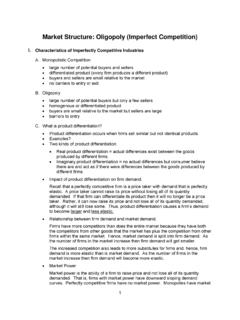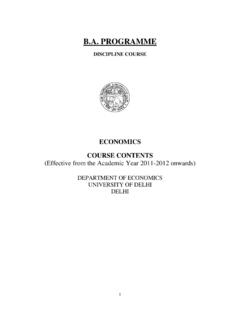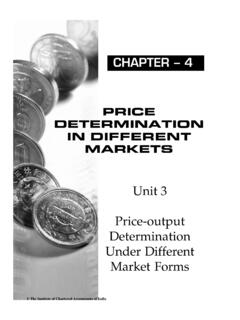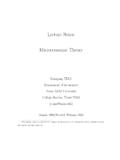Transcription of Mark Scheme (Results) June 2015 - Edexcel
1 Mark Scheme (Results) June 2015 GCE Economics (6EC03/01) Edexcel and BTEC Qualifications Edexcel and BTEC qualifications are awarded by Pearson, the UK s largest awarding body. We provide a wide range of qualifications including academic, vocational, occupational and specific programmes for employers. For further information visit our qualifications websites at or Alternatively, you can get in touch with us using the details on our contact us page at Pearson: helping people progress, everywhere Pearson aspires to be the world s leading learning company. Our aim is to help everyone progress in their lives through education. We believe in every kind of learning, for all kinds of people, wherever they are in the world. We ve been involved in education for over 150 years, and by working across 70 countries, in 100 languages, we have built an international reputation for our commitment to high standards and raising achievement through innovation in education.
2 Find out more about how we can help you and your students at: Summer 2015 Publications Code UA041304 All the material in this publication is copyright Pearson Education Ltd 2015 General Marking Guidance All candidates must receive the same treatment. Examiners must mark the first candidate in exactly the same way as they mark the last. Mark schemes should be applied positively. Candidates must be rewarded for what they have shown they can do rather than penalised for omissions. Examiners should mark according to the mark Scheme not according to their perception of where the grade boundaries may lie. There is no ceiling on achievement. All marks on the mark Scheme should be used appropriately. All the marks on the mark Scheme are designed to be awarded. Examiners should always award full marks if deserved, if the answer matches the mark Scheme . Examiners should also be prepared to award zero marks if the candidate s response is not worthy of credit according to the mark Scheme .
3 Where some judgement is required, mark schemes will provide the principles by which marks will be awarded and exemplification may be limited. When examiners are in doubt regarding the application of the mark Scheme to a candidate s response, the team leader must be consulted. Crossed out work should be marked UNLESS the candidate has replaced it with an alternative response. General marking guidelines 6EC03 Supported Choice Questions Maximum score: if an incorrect key has been chosen, the maximum score is 2 out of 4. Knocking out incorrect options: Incorrect options can be knocked out, if relevant economic reasoning is given, for 1 mark each time. Up to two knock out marks can be awarded for each supported choice question. If more than one key is knocked out for the same reason this will earn one mark only. Knock out marks are not awarded if the reasoning is that it s not A because it is B there must be some valid economics rationale to the answer in order to earn a mark.
4 Question Number Mark Scheme Mark 1 Key: E 1 Definition of market share or high market share (1) Explanation of a demerger beyond form two separate companies (as this is in the question), for example, break up of monopoly, reduce dominance in market (1) Reasons for competition authorities to act/firms may have been exploiting their high market power (hence the need to break them up) (1+1) to reduce monopoly power, increase contestability, to increase choice, lower prices, reduce inefficiency/x-inefficiency, diseconomies of scale Application to data (1) Lloyds will compete on the High St with TSB to offer lower prices/better service Role of competition authorities (1) to protect the consumer, promote competition , act as a surrogate for competition Example of knock out marks: It is not A because a rise in LRAC (diseconomies of scale) is an issue the bank might want to address because of falling profits, but it is not likely to have a damaging effect on the consumer so intervention unnecessary (1) 3 Question Number Mark Scheme Mark 2 Key: B 1 Definition of barrier to entry (1) an obstacle used to prevent new firms entering an industry Outline of how predatory pricing works (1) by making short term losses to force out firms Concept of predatory or limit pricing can apply to barriers to entry and keeping competition out (1) Firm makes a loss (1) which might be shown on a diagram (AR>AC over a quantity) Other diagram marks: allow limit pricing if firm is pricing below AC of other firms (1) Long run benefits or costs to firm (1) low prices prevent new firms from entering, higher profits for firms Illegal or anti-competitive (1) Example of knock out marks.
5 It is not C because a cartel is when firms act together as if they were one firm, and this would mean they do not have to undercut other firms 3 Question Number Mark Scheme Mark 3 Key: D 1 Definition of average revenue (1) TR/Q or demand or price Characteristic of perfect competition (1) many firms, no firm has market power, identical products The firm is a price taker (unless awarded above) (1) Perfectly elastic, horizontal or constant demand (unless awarded above) (1) Diagram showing total revenue (diagonal straight line passing through the origin) (1) or market diagram S and D determining price for an individual firm (1) Example of knock out marks: It is not A because this shows the shape of the total revenue for a price making firm (1) 3 Question Number Mark Scheme Mark 4 Key: D 1 Definition or characteristics of monopolistic competition (1) low or no barriers to entry or exit, slightly differentiated products, non-homogenous Function of supernormal profits in terms of entry (1) profits attract new entrants Normal profits are made in the long run (1) supernormal profits are eroded or competed away Application to context (1) shoe repair services are very cheap to set up and very little equipment or training is required Explanation that normal profits are where AR=AC or TC=TR or just enough profits to keep resources in their current use (1).
6 Diagram showing AC=AR (1) (if not awarded above as a written definition of normal profits), where MC=MR and AR is downward sloping (1): Revenue or costs ( ) Also award normal profit as TC=TR (verbal or on TR/TC diagram). Example of knock out marks:It is not C because in the short run, before other firms can enter or leave the industry, supernormal profits (or losses) can be made (1) 3 Question Number Mark Scheme Mark 5 Key: B 1 Explanation: Market share defined (1) the proportion of the sales relative to other firms Identification of first mover disadvantage (1) because Microsoft moves first it is at a disadvantage Undercutting prices as a way to increase sales (1) The goods are fairly close substitutes (1) Firms are interdependent (1) Pay off matrix (up to 2 marks) showing Sony benefitting from lower price (top right box) (1) Microsoft and Sony worse off (bottom right box) in long run equilibrium (1) Example of knock out marks.
7 It s not C because demand is relatively elastic in the short term, or the firm would lose revenue (1) It s not D because if they were colluding they would have sold at the same price 3 Question Number Mark Scheme Mark 6 Key: D 1 Definition or formula for concentration ratio (1) the largest 4 firms have x% of market power It is an oligopoly (1) Highly concentrated (1) a figure above 50% would indicate strong power Explanation of market power (1) e. g. firms can influence market price without losing a high proportion of sales Relation or application to industry (1) there are reasons why car industry might be hard to operate in a more competitive scenario or (within 1% range) of breakfast cereal market served by 4 main firms The implications of the market power (1) higher prices, the firms might collude Example of knock out marks: It is not B because food retailers have high sunk costs in establishing trusted brand names 3 Question Number Mark Scheme Mark 7 Key.
8 A 1 Revenue definition (1) money is coming into the firm, PxQ, turnover, value of sales Identification that this is price discrimination (1) Application to context (1) the senior citizen has a higher PED and is therefore not prepared to pay as much, or there are customers who have different elasticities because they have more free time Higher prices where demand is relatively inelastic on diagram or verbally (1) (see below left diagram, MR is not needed for the mark) Lower prices where demand is relatively elastic (1) (see below right diagram, MR is not needed for the mark) Main conditions for price discrimination (1) low or no arbitrage, separate sub markets with different elasticities Example of knock out marks: It is not C because arbitrage makes price discrimination impossible 3 Question Number Mark Scheme Mark 8 Key: A 1 Definition of performance targets (1) a level of quality of service that must be met or the firm will be fined, goal for a firm set for the firm, standard of service expectation, objective set for the firm Function of performance targets (1) they act as a surrogate for competition , or an incentive to become efficient because there is no competition , or to improve customer service Reasons why the fine was needed (1) x-inefficiency arising from lack of competition /monopoly power reducing incentives restores motivation/deterrent Impact of the fine (1) acts as a warning to other firms to meet their performance targets Application or example (1) punctuality of trains is 87% or intended to be 92%, or 5 percentage points below target Problems of efficiency in monopoly identified in diagram (1) AC rising for x-inefficiency Role of the regulator/ORR (1)
9 Surrogate for competition , promote consumer interests (not increase competition in this case) Example of knock out marks: Not D because a performance target is likely to decrease profits because costs rise 3 Question Number Mark Scheme Mark 9a Theory (2): Horizontal integration (1) with firms merging at the same stage of a production process or same product or firms are making the same type of product (1) increasing market share (1) Application (2) Chinese firms merging reduced the number of firms (1) from 200 to 50 (1); the firms are all producing baby milk powder (1); Inner Mongolia Industrial Group and China Mengniu Dairy supported in their merger (1); 30bn yuan or $ (1); increased ability of Chinese firms to compete with/drive away international rivals (1) NB if the answer is vertical integration then award no marks for theory, but application can still be relevant, government supporting baby milk suppliers 4 Question Number Mark Scheme Mark 9b KAA 2 marks + 2 marks reserved for diagram Subsidy defined (1) and explained (1): the subsidy is given to the firms, which implies costs are effectively reduced Effect on profits: they will increase (1 ) Diagram 2 marks: 1 mark for shift linked to new output (MC=MR).
10 See below at * for shifts allowed. 1 mark for larger profit or smaller loss area, and cost and revenue curves. The new/final area must be shown. *MC and AC shift (implied subsidy per unit of milk) if it is made clear that variable costs are falling with link to the new output or *AC shift (if just a lump sum to each producer) if it is made clear that fixed costs are falling with link to the new output Allow TR/TC diagrams also with TC shift down and increased distance between TR and TC. [AR and MR shift outwards only if subsidy is given to consumers that is, a consumption subsidy vouchers given to parents - although not implied in the data] Evaluation (4) Award as 2+2 or 3+1 or 4+0 marks. Factors might include: consideration of the limitations of subsidies opportunity cost, x-inefficiency long run benefits economies of scale subsidies are for mergers (Extract 3) and these might have increased costs, diseconomies of 8 scale Chinese firms cannot overcome the brand loyalty to foreign brands- so no guarantee of increased sales for domestic firms depends on the size and duration of the subsidy 30 billion yuan depends on whether or not the subsidy is passed onto consumers in terms of lower prices or kept within firm to develop products or for shareholders benefit the PED of consumers is low subsidy is small in relation to costs of firms not enough information to say for certain profits are still dependent on belief in Chinese firms and effectiveness of international brand loyalty is the subsidy linked to output?

















